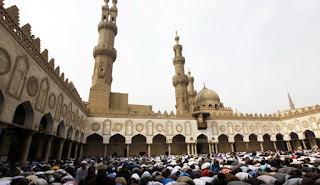(Unknown.The Sacred Lake of Karnak.LookLex:Encyclopaediahttp://i-cias.com/e.o/egypt.ancient.religion.htm)
The Early Egyptian religion, a pagan religion, honor various gods that had changed throughout the years both in name and importance. These Gods usually had specific purposes or things they would be in charge of. Amon Ra, was the Sun God, Isis was a Goddess who protected children and families. Evidence of this religion is marked in nearly every bit of Archaeological evidence found today. Paintings, artwork, statues, tombs, and monuments all were erected in some way or another to honor their religion and their gods. Even Pharaoh was considered a God on Earth. Although minor pieces of this religion had changed overtime, the fundamentals always remained!
(Fairchild, Alana. Goddess Isis. March 18, 2015. The Isis Reclamation Project.http://www.laylaisis.com/category/goddess/)
In the 1st Century A.D., Christianity began to spread across the Mediterranean. As the roman Empire acquired new territories, it brought with it Christianity. This gave Birth to the Coptic Christians, that still exist today. These Coptic Christians are said to be the original descendants of Ancient Egyptians. Trouble began to breakout between the Coptic and the Holy Roman Church over practices and dogmatic beliefs. Just over a hundred years later, the Coptic Christians separated themselves from the Roman Church, functioning fully on their own.
(Moha, Taco.Unnamed. August 26, 2010. The Holy Trip.https://plus.google.com/photos/+TacoMoha/albums/5509816435490902177)
Christianity began to be Challenged around 650A.D. when Islam started to spread throughout the Middle East and Northern Africa. Not long after Muslims set foot onto Egyptian soil was the entire nation under Islamic rule, where it remains today. Christians and Jews were allowed to continue ego practice their religions, but they were required to pay taxes and occasionally barred from certain political privileges. Eventually many Coptics converted to Islam. Where today, between three and ten million Coptic Christians remain in Egypt.
(Unknown.Unnamed.March 4, 2015. Pamela Gellar.http://pamelageller.com/2015/03/egyptian-government-closes-27000-mosques-in-move-to-fight-islamic-terrorism.html/)
Sources:
http://www.britannica.com/EBchecked/topic/180764/Egyptian-religion
http://cmes.arizona.edu/sites/cmes.arizona.edu/files/2c.%20History%20of%20Religion%20-%20powerpoint.pdf
http://p2048-www.liberty.edu.ezproxy.liberty.edu:2048/login?url=http://search.proquest.com.ezproxy.liberty.edu:2048/docview/2633033?accountid=12085









